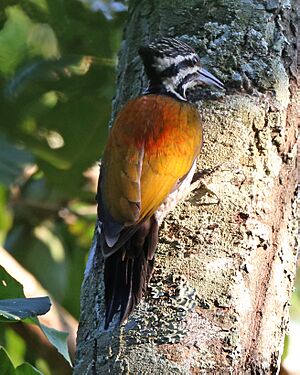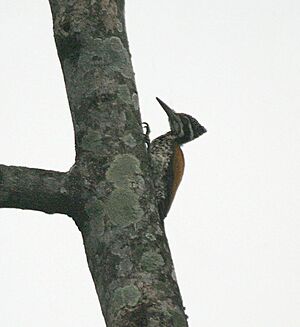Himalayan flameback facts for kids
Quick facts for kids Himalayan flameback |
|
|---|---|
 |
|
| Himalayan flameback at Chitwan, Nepal | |
| Conservation status | |
| Scientific classification | |
| Genus: |
Dinopium
|
| Species: |
shorii
|
The Himalayan flameback (Dinopium shorii) is a type of bird that lives in the Himalayas. It's also called the Himalayan goldenback. This bird belongs to the Picidae family, which includes woodpeckers. We don't know a lot about this bird yet, so scientists need to study it more. Right now, the Himalayan flameback is not in danger. But, cutting down too many trees (which is called deforestation) could really hurt how many of these birds there are.
Contents
What Does the Himalayan Flameback Look Like?
The Himalayan flameback looks a lot like another bird called the Greater Goldenback. But even though they look similar, they are not closely related. The main differences are that the Himalayan flameback is smaller and has a smaller beak.
You can spot a Himalayan flameback by a few key features:
- It has a black area on the back of its neck.
- Its throat has a brownish center. This brown color can sometimes go down to its chest.
- The brown area on its throat and chest has uneven black spots around it.
- It has a mustache-like stripe on its face that isn't very clear. The middle of this stripe is brownish. In males, it can sometimes be reddish.
- Their eyes are either reddish or brown.
- Unlike most birds, they only have three toes on each foot.
- The chest of the Himalayan flameback has uneven black streaks. Sometimes, the chest can be completely white.
- Their wings are a coppery brown or red color.
There are also differences between males and females:
- Male Himalayan flamebacks have a yellowish-red forehead. This color becomes more red on the top of their head, which is called the crest.
- Female Himalayan flamebacks have a crest that is completely black with white streaks.
- Both male and female birds have white and black bands on each side of their head, bordering their crest.
Himalayan Flameback Family Tree
The Himalayan flameback is part of the Picidae family, which includes all woodpeckers. It belongs to the genus Dinopium. Birds in this group are special because they only have three toes.
The Himalayan flameback is very closely related to the Common flameback. They form what scientists call a "superspecies." This means they are very similar and likely came from a common ancestor.
There are also two types of Himalayan flamebacks, called subspecies:
- D.s. shorii
- D.s. anguste
The closest relatives to the Himalayan flameback are the Meiglyptes tristis and the Celeus brachyurus. These are known as "sister species."
The name "shorii" for this bird honors a person named Frederick John Shore. He was an official with the East India Company. Mr. Shore sent a sample of the bird to a group of scientists in London. They then described and named the bird after him.
Where Do Himalayan Flamebacks Live?
Himalayan flamebacks are often found in the Indian subcontinent. They mostly live in the lower and middle parts of the Himalayas, in forests known as sal forests.
Their home range includes several countries:
They live in these areas all year round. There's also a separate group of these birds living in the south-eastern Ghats region of India.
The Himalayan flameback's habitat (where it lives) is mainly made up of mature tropical and subtropical deciduous forests. These are forests where trees lose their leaves each year. They also live in semi-evergreen forests, where some trees keep their leaves. They especially like lowland forests with Ficus (fig) and Bombax (silk cotton) trees.
Himalayan Flameback Behavior
Vocalization: What Sounds Do They Make?
The Himalayan flameback has a special call. It sounds like a quick series of "klak-klak-klak-klak-klak." This call is slower and softer than the call of the Greater Goldenback.
Diet: What Do They Eat?
We don't know much about what Himalayan flamebacks eat. They often join groups of other birds, like the Greater Goldenback, to find food together. Scientists believe their main food is insects, just like many other types of woodpeckers.
Reproduction: How Do They Have Babies?
Very little is known about how Himalayan flamebacks breed. We do know that they have their babies between March and May. They make their nests in holes that they dig out in trees. A female Himalayan flameback usually lays 2 to 3 eggs at a time.



